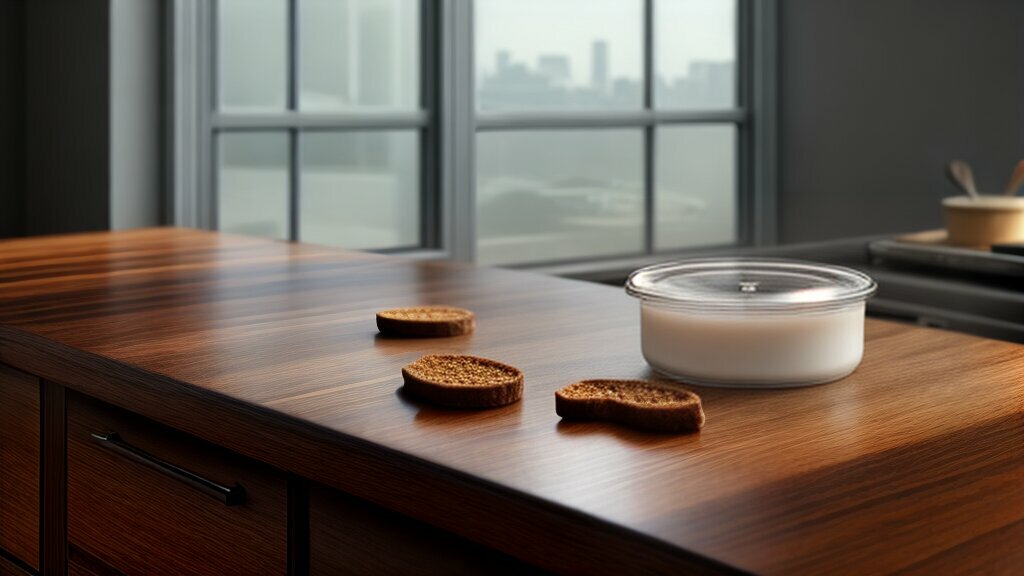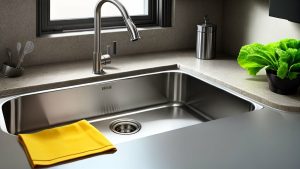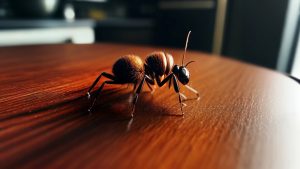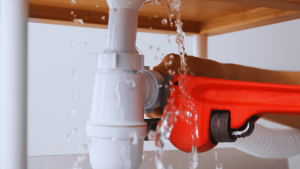Welcome to our article on using baking soda to rid your kitchen of ants! Ant infestations can be a pesky problem for many homeowners, but the good news is that there are natural and safe solutions to control them. This section will share some easy tips on using baking soda to eliminate ants in your kitchen.
Baking soda is a versatile and cost-effective ingredient found in most households. It’s helpful in cooking and cleaning and as an ant control method. Unlike chemical pesticides, baking soda is a natural and non-toxic alternative safe for kids and pets.
In the following sections, we will walk you through why baking soda is an ideal choice for ant control, explain how it works as a natural ant repellent, and provide step-by-step guidance on preparing and applying it in your kitchen. We will also share tips on keeping your kitchen ant-free and advise when to seek professional help for ant extermination.
Key Takeaways:
- Baking soda is a natural and safe substitute for chemical pesticides when dealing with ant control.
- In the following sections, we will explain why baking soda is an ideal choice for ant control, how it works as a natural ant repellent, and provide step-by-step guidance on preparing and applying it in your kitchen.
- Extra tips will be shared on how to keep your kitchen ant-free in the long run.
- If ant infestation persists despite your efforts, it’s recommended to seek professional pest control assistance.

Why Choose Baking Soda for Ant Control?
Regarding DIY ant control, baking soda is a popular choice for homeowners. Here are some reasons why:
| Reason | Explanation |
|---|---|
| Natural and safe | Baking soda is a natural product that’s safe for humans and pets. It is also environmentally friendly, an excellent alternative to harmful chemical ant killers. |
| Cost-effective | Baking soda is an affordable solution for ant control. It is a common household item, and you won’t have to spend much money on expensive pest control products. |
| Effective and versatile | Baking soda can be used in various ways to control and repel ants. Using it as a repellent or an ant bait can eliminate ants and prevent them from returning. |
Overall, choosing baking soda for ant control provides an accessible, natural, and effective solution for homeowners. The next section will explain how baking soda is a natural ant repellent.
Understanding How Baking Soda Works as a Natural Ant Repellent
While baking soda may seem like a simple kitchen ingredient, it has remarkable properties that make it an effective natural ant repellent. Baking soda, recognized as sodium bicarbonate, is a finely textured powder with alkaline properties.
When ants come in contact with baking soda, they absorb it and attempt to consume it. However, baking soda reacts with the acid in their digestive systems, causing them to produce excess carbon dioxide. This reaction leads to a buildup of gas in the ants’ digestive tracts, ultimately causing them to die.
Moreover, baking soda disturbs ants’ olfactory capabilities, which they utilize for navigation and identifying food sources. These insects communicate through pheromones, yet baking soda disrupts these chemical cues, complicating ants’ ability to pinpoint their nourishment.
Aside from its ant-killing properties, baking soda also works as a repellent. The fine powder has a rough texture that irritates the ants’ bodies, making it uncomfortable for them to walk on. As a result, they avoid crossing over baking soda-lined areas or entering baking soda-infused traps.
Preparation: How to Use Baking Soda to Get Rid of Ants
Preparing the mixture correctly is crucial before using baking soda to control ants in your kitchen. Here’s how:
- Grab a small container, such as a jar lid or a bottle cap.
- Blend equivalent amounts of baking soda and powdered sugar within the container. The sugar entices the ants, while the baking soda incapacitates their digestive system.
- Place the mixture in areas where ants have been spotted, keeping it out of reach of pets and children.
- Please wait for the ants to take the bait, then watch as they begin to disappear.
It’s important to remember that baking soda alone won’t eliminate an ant infestation. To tackle the problem effectively, combining baking soda with other methods, such as ant baits or traps, is best.
Creating Baking Soda Ant Baits
Aside from employing baking soda as a repellent, creating ant baits can effectively control ant infestations in your kitchen. Ant baits attract ants with a food source, such as sugar or honey, and then kill them with a toxic substance, such as baking soda.
To create a baking soda ant bait, follow these simple steps:
| Ingredients | Instructions |
|---|---|
| 1/4 cup sugar |
|
It’s important to note that this bait will only work on certain types of ants. If you need clarification on what kind of ants you’re dealing with or if the trick doesn’t seem to work, it may be best to contact a professional pest control service.
Additionally, monitor the bait regularly and replace it as needed. It may be ineffective if the trick dries out or becomes contaminated with debris.
Creating your baking soda ant bait is an easy and affordable way to control ant infestations in your kitchen. Combining baking soda with other common household ingredients can make a potent ant-killing, safe, and environmentally friendly mixture.
Placing Baking Soda Ant Traps in Your Kitchen
Now that your baking soda ant traps are ready, placing them in your kitchen is crucial to maximizing their effectiveness. Here are some tips:
| Location | Why? |
|---|---|
| Near ant trails | Ants typically follow a scent trail, so placing the traps directly in their path can help intercept them. |
| In corners and dark areas | Ants prefer to travel along walls and dark areas, so placing traps in these locations can help catch them. |
| Under appliances and furniture | Ants often seek shelter and food in hard-to-reach areas, so placing traps in these locations can help eliminate them. |
It’s essential to remember that the traps may attract more ants initially as they are drawn to the bait. However, the traps should reduce the number of ants in your kitchen over time.
We also recommend checking the traps regularly and replacing them with fresh ones every few days until you notice no more ants. If the problem persists, you may need to try additional methods or seek professional help.
Additional Tips for Ant Control Using Baking Soda
While the baking soda method is effective in getting rid of ants, there are a few additional steps you can take to thwart their return.
- Regular cleaning: A clean kitchen is the first defense against ants. Wipe down counters, sweep floors, and keep food in airtight containers to prevent attracting ants.
- Sealing entry points: Ants can find their way into your kitchen through even the tiniest cracks and gaps. Utilize caulk or weather stripping to seal off entry points and obstruct their access.
- Trimming trees and bushes: Ants can use trees and bushes as bridges to enter your home. Keep branches and foliage trimmed back away from your home to prevent this.
- Limiting moisture: Ants need water to survive, so fix any leaks or standing water sources in your kitchen.
Tip: If you have a persistent ant problem, try combining baking soda with other natural ant repellents such as vinegar, citrus peels, or essential oils. These ingredients can be used with baking soda to deter ants further.
By implementing these additional tips, you can boost the effectiveness of your baking soda and control efforts and maintain a pest-free kitchen.
Safety Precautions When Using Baking Soda for Ant Control
While baking soda is a natural and safe alternative to chemical ant control methods, it’s still important to take some precautions to ensure everyone’s well-being. Here are some safety measures to keep in mind:
- Keep baking soda out of reach of children and pets: Store it securely where kids and pets can’t access it. Although baking soda is not toxic, ingesting large quantities can cause stomach upset and other discomforts.
- Avoid inhalation: While mixing or applying baking soda, cover your nose and mouth to prevent inhalation, as it may irritate your lungs and cause respiratory problems.
- Wear gloves: To avoid skin irritation and potential allergic reactions, it’s best to wear gloves when handling baking soda and other ingredients.
- Don’t mix baking soda with other cleaning solutions: Baking soda should not be combined with vinegar, ammonia, or other cleaning products, as it can induce a chemical reaction resulting in toxic fumes.
Following these safety guidelines, you can prudently and efficaciously employ baking soda for ant control within your kitchen.
Monitoring and Maintaining a Pest-Free Kitchen
Since you have successfully eliminated ants from your kitchen using baking soda, taking measures to prevent their return is essential. Here are some tips to help you maintain a pest-free kitchen:
- Place food items within airtight containers to deter ants from detecting and reaching them.
- Wipe down countertops and surfaces with a mixture of water and white vinegar to deter ants from tracking in search of food.
- Regularly sweep and vacuum your kitchen floor to remove any crumbs or food debris that could attract ants.
- Rectify any leaky pipes or faucets to eradicate a water source crucial for ants’ sustenance.
- Close off cracks or openings in walls, floors, and windows to thwart ants from infiltrating your kitchen from the outdoors.
Following these tips and monitoring your kitchen regularly can maintain a pest-free environment free from ants and other unwanted pests.
When to Seek Professional Help
While DIY ant control methods using baking soda can be effective in most cases, there are occasions when seeking professional help may be necessary. Here are some situations where it’s recommended to call in the experts:
- If you have a severe ant infestation that doesn’t respond to DIY remedies, contact a professional pest control service. Professional pest control services possess specialized tools and chemicals to eradicate ants and forestall subsequent infestations efficiently.
- If you have allergies or sensitivities to insecticides or ant repellents, it’s safer to leave the task of ant extermination to the professionals. They can use eco-friendly and non-toxic methods to ensure your home remains safe and healthy.
- If you have tried multiple DIY ant control methods without success, it’s time to bring in the experts. They can thoroughly inspect your home and identify the root cause of the problem, ensuring a long-term solution.
Remember, professional pest control services are trained and experienced in dealing with all types of ant infestations, from minor to severe. Feel free to seek their help if you feel overwhelmed or unsure about tackling the problem alone.
Conclusion
We hope this guide on how to rid your kitchen of ants using baking soda has been helpful. Baking soda is a secure and efficient natural ant repellent that can save you the trouble and expense of hiring professional pest control services. You can easily make ant control a DIY project by following our tips and methods.
Remember that prevention plays a pivotal role in upholding a kitchen free from pests, so be sure to keep your counters and floors clean, store your food correctly, and seal any cracks or gaps where ants can enter. If you encounter a stubborn ant infestation that cannot be controlled with baking soda, don’t hesitate to seek the help of a professional exterminator.
Ultimately, you can relish a pristine, sanitary kitchen devoid of ant invasions by dedicating patience and effort. Happy baking soda and control!
FAQ
Q: How can I use baking soda to eliminate ants in my kitchen?
A: Using baking soda to rid your kitchen of ants is easy. Generate a blend of baking soda and powdered sugar, then position it in locations frequented by ants. The ants will be lured by the sugar and ingest the baking soda, resulting in their demise.
Q: Why should I choose baking soda for ant control?
A: Baking soda is a safe and effective DIY solution for getting rid of ants. It is a versatile household ingredient that is non-toxic and environmentally friendly. Plus, it is readily available and affordable.
Q: How does baking soda work as a natural ant repellent?
A: Baking soda works by disrupting the ants’ exoskeleton and causing them to dehydrate. When ants come into contact with the baking soda mixture, it damages their outer layer, leading to their eventual demise.
Q: How do I prepare and use baking soda to eliminate ants?
A: For ant control using baking soda, combine equal proportions of baking soda and powdered sugar. Place the mixture near ant trails or areas where ants are commonly seen. Reapply the mixture as needed until the ant infestation is eliminated.
Q: Can I create ant baits using baking soda?
A: Yes, you can create ant baits using baking soda. Mix baking soda with common household ingredients like honey or syrup to attract ants. Place the bait in ant-infested areas and monitor the traps for ant activity.
Q: Where should I place baking soda ant traps in my kitchen?
A: To maximize the effectiveness of baking soda ant traps, place them near ant entry points, such as cracks, windows, or doors. Also, set the traps in areas where ants are commonly seen, such as near the sink or pantry.
Q: Are there any additional tips for ant control using baking soda?
A: Alongside using baking soda, you can take additional measures to control ants in your kitchen. These include keeping your kitchen clean and free of food debris, sealing any cracks or openings where ants can enter, and removing sources of moisture that attract ants.
Q: What safety precautions should I take when using baking soda for ant control?
A: While baking soda is generally safe, it’s still important to handle it cautiously. Avoid inhaling the powder and keep it away from children and pets. If you have concerns, consult a professional before using baking soda for ant control.
Q: How do I maintain a pest-free kitchen after using baking soda for ant control?
A: To maintain a pest-free kitchen, maintain good hygiene and cleanliness. Regularly clean surfaces and eliminate food spills or crumbs that may attract ants. Also, seal any potential entry points to prevent ants from returning.
Q: When should I seek professional help for ant extermination?
A: While baking soda can be effective, there may be situations where professional pest control is necessary. If the ant infestation persists or you have a severe infestation, it’s recommended to seek professional assistance for thorough ant extermination.

It’s me, Amber Hayden, the heart and soul behind SagarmathaOnlineMedia.com. From a young age, I’ve been head over heels for everything home-related, from interior decor to gardening. I’m the type who can’t resist a well-crafted piece of furniture, and I firmly believe that a home isn’t complete without a pet or two. But it’s not just about creating pretty spaces for me. I’m all about making homes that tell a story reflecting the people living there. SagarmathaOnlineMedia.com is my way of sharing this passion with you. Whether you’re looking for tips to jazz up your living room, advice on pet care, or ideas to make your garden bloom, I’m here to help. So, let’s embark on this journey together and make your house a home!



